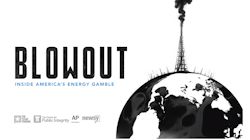SEJournal Online is the digital news magazine of the Society of Environmental Journalists. Learn more about SEJournal Online, including submission, subscription and advertising information.
Inside Story: ‘The Power of Partnerships’ Helps Uncover America’s Energy Gamble
In a far-flung team journalism project, Jamie Smith Hopkins and a team of journalists from the Center for Public Integrity, Texas Tribune, Newsy and the Associated Press worked together for a hybrid series, combining in-depth articles and a video documentary about America’s energy policies.
 |
“Blowout: Inside America’s Energy Gamble” took a deep dive into the lifting of regulations on air pollution and drilling sites, which upset local residents but was touted by legislators as a jobs creator. And it also uncovered the interests which made the United States a major oil exporter despite efforts around the world to cut down on fossil fuel use.
The project eventually won second place honors for outstanding explanatory reporting in the Society of Environmental Journalists’ 2019 Annual Awards for Reporting on the Environment. Judges called it “a compelling series that probes the environmental and climate health effects of the country’s biggest oil and natural gas production boom in West Texas and part of New Mexico.”
SEJournal Online recently caught up with Hopkins, environment editor and reporter at the Center for Public Integrity. Here is the conversation.
SEJournal: How did you get your winning story idea?
Jamie Smith Hopkins: It started with a single observation in a fall 2017 International Energy Agency report. Jim Morris, now the executive editor at the Center for Public Integrity and then the editor running our environment team, was struck by the IEA’s prediction of an unprecedented surge in overseas shipments of oil and liquefied natural gas, largely from the United States.
‘The U.S. was tacitly (and explicitly, in some cases)
encouraging the world to expand or extend its use
of products contributing to the climate crisis.’
— Jamie Smith Hopkins
We’d known there was a drilling boom in West Texas. What we hadn’t grasped is how much that was fueled by new opportunities to send these fossil fuels to other countries. The United States was tacitly (and explicitly, in some cases) encouraging the world to expand or extend its use of products contributing to the climate crisis.
Early in 2018, we reached out to The Texas Tribune, Newsy and The Associated Press to see if they would like to join forces. We knew it would be a far stronger project with the combined might of four newsrooms.
SEJournal: What was the biggest challenge in reporting the series and how did you solve that challenge?
Hopkins: Any complex, multi-story series presents a variety of hurdles. Among those in this case: Getting and making sense of data. We filed a lot of public-records requests and used a spreadsheet to track the datasets we had or were trying to acquire. (A multi-newsroom partnership is helpful when agencies demand fees: We split the charges four ways.)
SEJournal: What most surprised you about your findings?
Hopkins: We knew the nation’s surge in fossil-fuel exports predated the Trump administration. But the role the Obama administration played — especially on natural gas — was really striking. Public Integrity reporter Jie Jenny Zou found a coalition of White House advisers with links to firms profiting from the boom had echoed the industry’s message that exports would be a win-win.
The Washington policy changes have had big effects in West Texas, epicenter of U.S. drilling. The impact ripples far beyond the number of jobs and size of paychecks. The Texas Tribune’s Kiah Collier, Public Integrity’s Rachel Leven and I focused on those local impacts: a spike in traffic accidents, billions of dollars in road damage from heavy trucks, a school district short several hundred teachers, spiraling housing costs, air pollution and earthquakes. The breadth of local challenges was eye-opening.
SEJournal: How did you decide to tell the story/series and why?
Hopkins: Newsy told its story as a feature-length documentary (now available on Amazon), an ambitious move that allowed Zach Toombs and his team to take viewers to Texas, Colorado, the Panama Canal, India and Bangladesh — all the while noting how people are impacted and how global warming hangs over everything.
 |
The rest of the stories were text, in some cases with interactive elements. For the lead story, we wanted to capture the chaos we were seeing on the ground in West Texas, so we focused on several communities caught up in export-fueled change.
SEJournal: What would you do differently now, if anything, in reporting or telling the series and why?
Hopkins: One lesson learned: Data is great but trying to quantify everything yourself isn’t necessarily a good idea. You can save a lot of time — and focus on the highest-value questions — if you prioritize. There’s probably no need to recreate what academics or other reputable sources have already measured.
SEJournal: What lessons have you learned from your story or project?
Hopkins: It reinforced the power of partnerships. Together, our newsrooms produced seven stories and a documentary. Eight reporters worked on the series alongside numerous editors, photographers, data journalists, videographers and other professionals. We couldn’t have done it individually.
The Texas Tribune has a deep understanding of its state and came up with ideas the rest of us would probably never have thought of. Newsy traveled the world for its documentary, showing how the local and the global intersect. The Associated Press put all our stories on its wire so other news organizations could easily access them. Public Integrity extracted data and documents from agencies loath to give them up. And all of us contributed reporting that made the series work.
SEJournal: What practical advice would you give to other reporters pursuing similar projects, including any specific techniques or tools you used and could tell us more about?
Hopkins: If you’re embarking on a project with multiple newsrooms, stay in touch. Regular check-ins are a good idea, and you want to make communication as easy as possible. We set up a multi-newsroom Slack and used Google Docs for co-reported stories.
Jamie Smith Hopkins is the environment editor and a senior reporter for the Center for Public Integrity. Her work includes investigations about America’s fossil fuel export boom, the federal government’s failure to stop a decades-long string of deaths from a widely available consumer product and “super polluter” industrial sites pumping out large amounts of toxic air pollution and climate-warming greenhouse gases. Before joining Public Integrity in 2014, she spent 15 years as a reporter for The Baltimore Sun. Honors for her stories include awards from the Society of Environmental Journalists, the Education Writers Association and the Society for Advancing Business Editing and Writing.
Also reporting on the “Blowout” series were Jie Jenny Zou, Rachel Leven, Jim Morris, Pratheek Rebala, Dave Harmon, Kiah Collier, Jerod Foster, Marjorie Kamys Cotera, Darla Cameron, Chris Essig, Ellen Weiss, Zach Toombs, Kate Grumke, Kevin Clancy, Kyle Pyatt, Jennifer Smart, Michael Hudson, Michael Biesecker and Kim Tong-Hyung.
* From the weekly news magazine SEJournal Online, Vol. 5, No. 32. Content from each new issue of SEJournal Online is available to the public via the SEJournal Online main page. Subscribe to the e-newsletter here. And see past issues of the SEJournal archived here.













 Advertisement
Advertisement 




